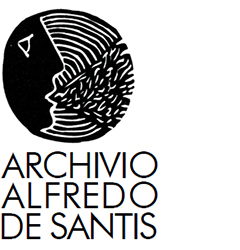It is easy and perhaps common to note that many elements in Alfredo de Santis’ drawing and painting are derived, purposely, I am sure, from his experience in graphics: In any case, an artist is a product of his own experience… but also the continuity of attempting to liberate himself from inside, with a return to areas that seem to precede gains, is a proof of secure ability. To return into uncertainty, to accept actively the loss of significances everything that is necessary.
Thus taking away, a reduction, a refusal of narrative support, concentrating however on an object, on a gesture paradoxically closed. And thus the space is purely mental: there I not a distinction between the background and foreground, and, on the other hand, there I no need to resort to optical illusion.
And again: objects with function, elements that balance themselves above and beyond their recognizable difference. And an ulterior result of mental existence, of abstraction: Painting becomes the protagonist as symbol: it yields either figuratively (the palette, painting, canvas) or in the structure of light and transparent brushstrokes. And the distinction/fusion re-proposes itself in chromatic solutions: balance of colour independent from the realistic exigence of the object.
Why painting, a painter? A kind of re-flexion transferred to his own profession. The professional of drawing and painting, the manipulator of image, the person in grips with relationships, with significances, the graphic artist anyway objectifies some symbols of his work or his entire self. And from inside his daily work emerges that which wants to be different. Painting inside painting as theatre inside theatre: something in his double speculative sense but with a a share of ambiguity and pretence that is nothing other than creation. The canvas and the page are not only the specific support of painting, they are the space, the symbol of all space, and thus the artist cannot occupy only one part of something that is not completely available.
In the space, a few details, each barely accented. Man is also a detail: and this doesn’t diminish him because he brings it to an indefinite totality. The man in the landscape as an armchair or easel in the landscape. Relative: no one thing is preponderant when it is alone. The isolated accentuation, which interests De Santis, to build images and illuminating emotions together with nature. The artist doesn’t want to appropriate from nature because that would signify violence, the opposite of the perennial presumption of man. He moreover searches for participation that finds the way to images via synthesis and condensation. From those trees, armchairs, easels as discreet models, that live from their existence, without clarity and realistic differentiation. Models. Thus symbols? Inevitably. But not symbols or the weight of metaphor and allegory. Happenings and things b chance, but with the necessity of that which resorts to experience, as well as dreams. Alfredo De Santis figurative. But in what frame of reference? With what appearance? First the general problem.
It is critically acknowledged that abstraction does not irreversibly link the evolving line of figuration. On the other hand, one can not say that it is a typical meaning of the qualitative differentiation of results to distinguish that which is research and that of premeditation.
Certainly De Santis is among the searchers with an inventive re-flexion on painting as a means and as an object. The concept is not only the visibility of painting, the theme, indefinitely varied of the “painter and the model”, the tubes that drip colour (Arman), Jim Dine with his almost catalogue of colours, Toy Lichtenstein with his brushstrokes, isolated with a large and sinuous gigantic brush on the dotted field of the cliché. It is as a conversation with themselves and together abstraction is taken to the limit: it is not the content of the painting but only the means of painting. Thus concept, visibility, and pretence. It was not thinkable that before the complexity of reality, to the unevenness of the experience, to the mix of conscious/unconscious, memory/present, project/chance, various forms of abstraction and jeopardize, pop, conceptual art, etc., that a decade ago was the avant-guard, doesn’t feel the need to open a new road by unhidden figuration. The exigence of the image as a new research was born, that knows the progression from figuration to photography, cinema, TV and not as a return to the past also though, in this movement surface allusions to the art of the past infiltrate citations that represent with ambitious intentions an homage to…. Before coming to the most recent and already appropriate revisitation.
As an attestation of pluralism, one thinks also of the possibility offered by the electronic elaboration of the form and colour in common transmissions as well as video art.
If the form is also to explore and to recombine in order to impose a new style it is already fashionable and easy to give confidence to the conceptual (that pretends to say much ore than it represents) or to an abstraction incapable of retaking its own comparison with reality. And maybe that abstraction at its birth gives force to the realistic, for example, like Kandinsky? Without fictional approaches (another thing is the histrionics of a product), without hierarchic debts, an evaluation of De Santis’ work remains in the field of the essential problems of art, especially the justification of art that is not secure once and for all.

